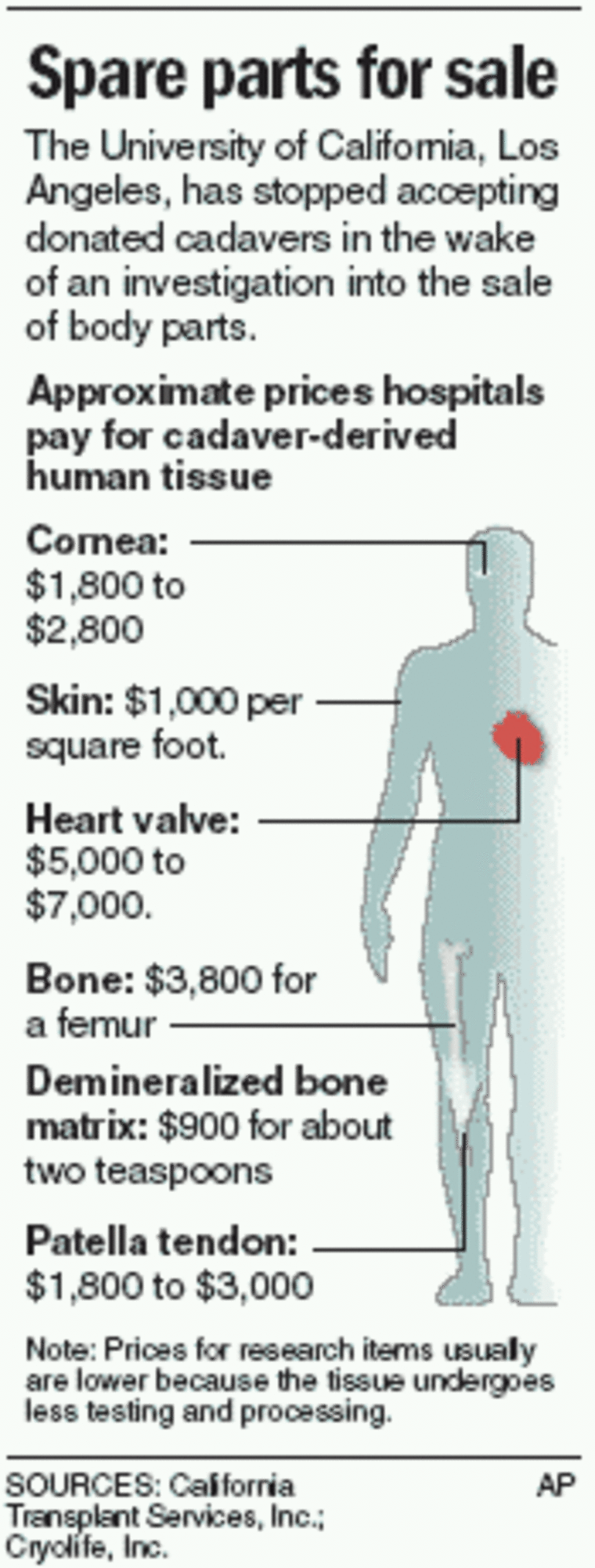Collagen to plump up starlets’ lips. New knees to enable weekend athletes to play basketball again. Skin for burn victims. Cadavers for surgeons to practice on.
A corpse-selling scandal at UCLA has underlined a squeamish fact for people thinking of leaving their remains to science: Bodies are big money.
And not only that, but some aspects of the industry are virtually unregulated.
“It’s a wild, wild West out there in tissue land, with few sheriffs and a lot of shady characters meeting in the back rooms,” said Dr. Art Caplan, a professor of bioethics at the University of Pennsylvania and columnist for MSNBC.com.
On Tuesday, the University of California at Los Angeles, which receives an average of 175 donated corpses a year, agreed to a court order to stop accepting such cadavers until an investigation is completed into allegations that two men, including the director of the university’s Willed Body Program, sold body parts on the side for their own profit.
Johnson & Johnson bought cadavers
Director Henry Reid and Ernest V. Nelson, who is not a UCLA employee, were arrested over the weekend. The Los Angeles Times reported that it was shown invoices on a UCLA letterhead indicating 496 cadavers were sold for a total of $704,600 between 1998 and 2003. One client was pharmaceutical giant Johnson & Johnson.
The company said a subsidiary called Mitek obtained tissue from Nelson in the 1990s, but added, “Mitek did not knowingly receive samples that may have been obtained in an inappropriate way.”
“We take the matter of using human tissue samples for medical research and education very seriously. We are sensitive to the need that all samples are appropriately and properly obtained, stored and shipped,” Johnson & Johnson said in a statement.
Donated cadavers and the corneas, tendons, skin and other parts taken from them are in high demand for transplants, medical training and research by universities and companies. Experts say the U.S. human tissue industry is worth hundreds of millions of dollars a year.
Demand always outstrips supply. Each year, about 20,000 bodies are donated and about 1 million transplants involving human tissue are performed, said Bob Rigney, chief executive of the American Association of Tissue Banks, which has 83 members banks. He estimated that both donations and demand are increasing by 5 percent to 10 percent annually.
A vast array of uses
Tendons and ligaments are used to treat sports injuries, long bones to replace those eaten away by cancer, shaped bone products for spinal surgery, ground bone in dental surgery. Cadavers supply corneas and heart valves; help medical students learn anatomy; give surgeons practice in cutting, stitching and other operating techniques; and have even served as crash-test dummies. Cadaver collagen finds its way into people’s lips.

Heart valves can fetch $5,000 to $7,000 each. Skin, used to dress the wounds of burn victims, can go for $1,000 a square foot. Brains, veins, fingernails — pretty much every part of a corpse can be valuable.
If a single body could provide all its organs, the cadaver would be worth $150,000, Caplan said.
About 150 willed-body programs run by universities and other entities supply medical schools with cadavers. UCLA started the world’s first such program in 1950. Donors often sign a contract giving the school broad leeway to use the body as it sees fit.
Under the Uniform Anatomical Gift Act, adopted by all 50 states, donors must give their consent to turn over their bodies or those of relatives. They are not paid, though some groups pay for the remains to be cremated.
No prohibition on buying, selling body parts
Technically, it is illegal in the United States to sell organs or other human tissue for transplant, but nonprofit organizations charge acquisition and handling fees, and that is where the big money lies. There is no prohibition on buying or selling body parts for research or medical education.
The network for supplying hearts, kidneys and other whole organs for transplant is tightly regulated. But there is less oversight for the hundreds of organizations that supply other cadaver tissue for transplant, and virtually none at all for those that supply material to researchers.
Organizations that procure tissue for transplant must be listed with the Food and Drug Administration, but only three states — California, New York and Texas — actually license such banks, said Marc Pablo, director of operations for California Transplant Inc. of Carlsbad, which supplies transplant tissue.
Over the past decade, scandals involving the sale of body parts on the black market have broken out universities and funeral homes.
Fears that patients will pay the price
Some fear the UCLA scandal could hurt the industry and patients who need transplants.
“You ask the public to trust you with the most precious of gifts, and then to violate that trust is just incomprehensible,” said Brent Bardsley, director of Anatomy Gifts Registry of Hanover, Md., which supplies tissue to researchers. “It affects the public’s willingness to donate.”
Caplan said: “I’ve got a donor card. People really will die if we don’t get them organs, and they shouldn’t be punished for the sins of people in the tissue collection world.”
John Aubain said his wife, Madge, died in 1999 at age 87 and willed her body to UCLA in the hope that it could be used to train surgeons. The Chatsworth resident now said he worries her body might have been sold.
“I think they’re really sick to do something like that,” he said. “Something like that should never happen. I know my wife would be very upset if she knew what was happening to her body.”